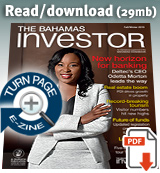| Source: Date: Updated: |
TheBahamasInvestor.com
Wednesday, May 18, 2011 Wednesday, May 18, 2011 |
The National Accounts Section of the Department of Statistics has announced the release of the 2010 preliminary estimates along with the historically revised estimates of gross domestic product (GDP) for the period 1997 to 2009.
The 2010 preliminary results are based on early estimates from major data sources such as The Central Bank of The Bahamas, Ministry of Tourism and Aviation, and the Foreign Trade Section of the Department of Statistics, among others. They are also based on indicators that normally mimic movements of particular industries, including hotel room rates, megawatt sales, building permits, chargeable telephone minutes, and the consumer price index.
The 2010 GDP figures are preliminary and as more data becomes available, the figures will be revised in keeping with international practices and procedures.
According to these early results, the GDP in current prices for 2010 had a negative growth of 1.35 per cent, as compared to 2009 that had a negative growth of 5.26 per cent. However, when measuring the real growth that occurred in the economy, (which is growth unencumbered by inflation) the Bahamian economy had a positive growth of 0.95 per cent in constant prices.
The differences in the growth patterns in constant and current prices in 2010 can be explained by examining the GDP by the expenditure approach, which is estimated as government and household consumption combined with investment and exports minus imports.
Exports account for approximately 30 per cent of the total value of the items that contribute to the GDP on the expenditure side, therefore, any change in this sector will also influence the results. In 2010, exports at current prices grew by $112 million, but at constant prices it grew at a higher rate increasing by $162 million, which contributed to the positive real GDP growth.
However, at current prices in 2009 the decrease was $680 million and in constant prices $218 million. This decrease was led by tourist expenditure, which fell in current prices by $499 million or 19 per cent. Preliminary estimates for tourist expenditure indicate that The Bahamas experienced a slight recovery in 2010 after this major decline in 2009.
The private final consumption expenditure, or household expenditure, fell by 6 per cent in real terms in 2009, but showed a slight recovery in 2010. In 2009, households had less disposable income due to job losses and increasing prices, but in 2010 had a slight recovery of a few jobs, some being employed with the government’s road improvement programme, construction on the airport project, the dredging and expansion of the harbour, refurbishment of Saunders Beach and completion of the government tourism complex.
Householders also substituted their lost earnings by becoming self-employed with informal businesses, such as food sales and retailing of goods and services (eg dressmaking, domestic work, gardening, phone card sales, etc). Consumer spending was also echoed in the repayment of loans and borrowing pattern between 2008 and 2010, which according to the Central Bank, consumer repayments of debt fell by 7 per cent in 2009, but increased by 2 per cent in 2010, and new credit extended to households by lending institutions, fell by 19 per cent in 2009, but increased by 2 per cent in 2010.
The changes between 2009 and 2010 were also influenced by government expenditure, which decreased at current prices by $8 million in 2010, as government reduced the spending of all its ministries and departments with the exception of Public Health, according to the latest available Government Treasury Report 2009/2010. However, with deflation at constant prices, the government final consumption expenditure increased by $7 million in 2010.
Data on mortgage commitments, obtained from the Central Bank February 2011 Report, showed that in 2010 residential mortgage commitments fell by $73 million and commercial commitments fell by $36 million. Preliminary estimates of construction services imported also show a decline of $5 million in 2010. The machinery and transportation equipment also decreased by $75 million. All of these inputs resulted in a gross capital formation (GCF) decrease in 2010.
In 2010, imports in current prices increased by $210 million, which contributed to the 1.35 per cent decline in GDP. However, in constant prices imports fell by $63 million, which influenced the slight increase in GDP. One of the contributing factors to this phenomenon was the increase in the global oil prices. The imports of goods and services were influenced by these oil prices as it represented 19 per cent of imports in 2008 ($852 million) and 2010 ($755 million), when it usually represented approximately 14 per cent of all imports.
The US export price index for petroleum and petroleum products was used to deflate the oil imports and then the remaining goods and services are deflated using the US export price index as 87.4 per cent of all The Bahamas imports came from the US.










